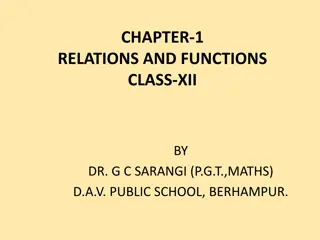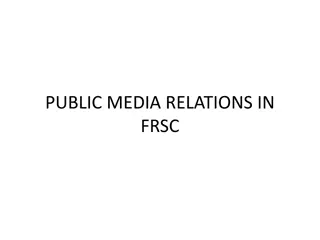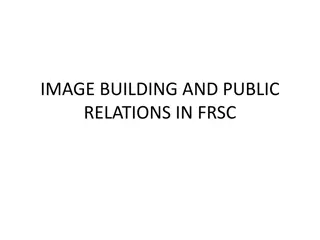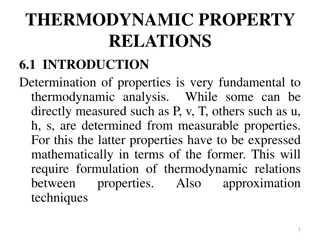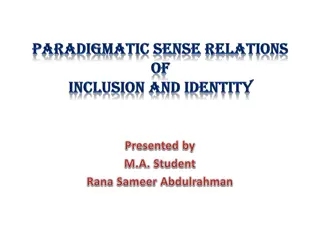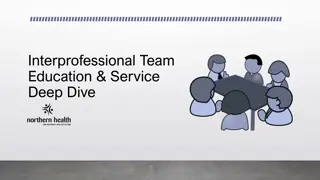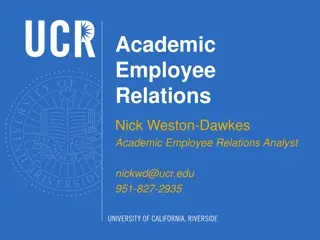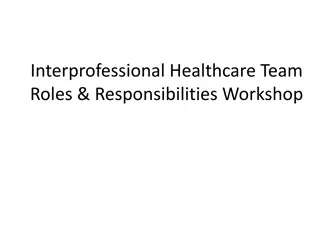Interprofessional Relations
Interprofessional relations play a vital role in the effectiveness of health care teams. Various professionals, such as physicians, pharmacists, nurses, and allied health professionals, collaborate to provide comprehensive patient care. Effective communication among team members is crucial to ensure optimal patient outcomes and prevent errors. Each member of the health care team contributes unique skills and knowledge to enhance patient care and overall team performance.
Download Presentation

Please find below an Image/Link to download the presentation.
The content on the website is provided AS IS for your information and personal use only. It may not be sold, licensed, or shared on other websites without obtaining consent from the author.If you encounter any issues during the download, it is possible that the publisher has removed the file from their server.
You are allowed to download the files provided on this website for personal or commercial use, subject to the condition that they are used lawfully. All files are the property of their respective owners.
The content on the website is provided AS IS for your information and personal use only. It may not be sold, licensed, or shared on other websites without obtaining consent from the author.
E N D
Presentation Transcript
Interprofessional Relations Dr. Haider Raheem Mohammad Dr. Haider Raheem Mohammad
Interprofessional Relations The term profession was formerly applied only to the church, the law and medicine the three learned professions. The meaning of the term is now broader, as is apparent from the definition in the Oxford English Dictionary: a vocation in which a professed knowledge of some department of learning is used in its application to the affairs of others, or in the practice of an art founded upon it . In modern usage, it seems that almost all occupations that require some measure of intellectual training can be described as professions. However, an organized profession requires more than the mere existence of an intellectual discipline.
Health care professionals The American Medical Association recognizes more than 80 health care related careers, including physician, pharmacist, nurse, and allied health professional. Allied health care professionals, also known as paramedicals, provide health care services and perform tasks under the direction of physicians.
The health care team The health care team consists of all health care professionals who have responsibility for patient care plus the patient. Although all members of the health care team interact directly with the patient, they rarely meet as a group; instead, information and recommendations are exchanged through written documentation. Verbal information exchange and recommendations occur on a less formal basis.
The health care team All members of the health care team contribute their profession s unique knowledge and skills. Pharmacists, the drug experts on the team, help teams develop, implement, and monitor the therapeutic regimen and provide drug information and education services to the patient and team. Students have a unique role on the health care team. Students represent their profession and are expected to carry out their professional responsibilities under the direct supervision of licensed professionals.
Communicating with Health Care Professionals Effective communication between pharmacists and physicians, nurses, and other pharmacists is essential. Poor communication not only leads to frustration and lack of respect among professions but also may compromise patient care if important information is misunderstood, ineffectively conveyed, or left out.
Pharmacist-Physician Communication Pharmacists and physicians often have trouble communicating with one another. Both professionals are extremely busy; communication usually takes place when neither party has much time to converse. Many pharmacists are intimidated by physicians (Figure 4.1).
Pharmacist-Physician Communication Be prepared with specific questions or facts and recommendations when initiating a patient care related conversation with physicians. Make sure other resources cannot answer the question. Stay within the pharmacist s area of expertise. Choose the right time and place for the conversation. Never interrupt a physician-patient interaction, except in a life threatening situation. Follow the chain of command. Do not go to an attending physician when the question or recommendation is more appropriate for a less senior member of the medical team. Do not interrupt teaching rounds with trivial questions and observations better communicated one to one with individual physicians. Do not engage physicians in lengthy social small talk.
Pharmacist-Physician Communication If the physician initiates the conversation, listen carefully, assess the information or question, and ask for additional information until the question is clear and specific. Physician-initiated questions often are vague and general. Clarify the question and obtain appropriate patient-related data. For example, a physician may ask if a serum digoxin concentration of 0.8 ng/mL is okay. Given that the usual therapeutic range is 0.8 to 2.0 ng/mL, the initial reaction is to confirm that a concentration of 0.8 ng/mL is okay. However, the question should not be answered until the pharmacist finds out why the drug was prescribed (i.e., for heart failure or for atrial fibrillation), when drug therapy was initiated, when the blood sample was obtained, what the clinical status of the patient is, and what is the goal of therapy.
Pharmacist-Nurse Communication Pharmacists and nurses also often have trouble communicating with one another. Pharmacists and nurses are extremely busy; communication often occurs when neither party has much time to spend talking. Unfortunately, in the acute care setting most pharmacist-nurse communication takes place because of drug distribution errors; much of the tension between the two professions is based on these interactions. Nurses are pressed to obtain and administer medication and pharmacists are frustrated because nonstat requests often are presented as emergencies (e.g., stat docusate sodium).
Pharmacist-Nurse Communication The pharmacist and the nurse end up in a tug-of-war over work priorities, which can lead to lack of respect and poor communication on the part of both professionals. Pharmacists and nurses must treat one another with respect; both professionals must realize that they share the same goal (e.g., optimal patient care) and are on the same patient care team. Communication should be clear, to the point, and timely.
Pharmacist-Pharmacist Communication Patient care may be less than optimal because of communication difficulties between pharmacists. For example, pharmacists on hospital- based consult services such as pharmacokinetics or infectious disease may not have access to recent uncharted patient information or be privy to in-depth discussions during team rounds. Pharmacists on the patient care team need to update consulting pharmacists frequently. Consulting pharmacists should be aware that the primary team may have more information than that documented in the patient record; they should not make recommendations in isolation.
Pharmacist-Pharmacist Communication Inpatient patient-focused care takes place 24 hours a day, 7 days a week. Continuity between shifts requires clear communication of patient information, plans for the patient, and other patient issues. A common communication system is the exchange of patient information during sign-out rounds or the discussion of patient-specific issues and the passing on of patient monitoring forms and other types of written documentation between the pharmacist leaving the service and the pharmacist assuming responsibility for the patient.
Pharmacist-Pharmacist Communication Community pharmacists and institutional pharmacists rarely share patient-related information. Although patients and other members of the health care team potentially benefit by knowing details regarding patient medications and status before hospitalization and upon discharge, the fragmented nature of traditional health care delivery systems makes this type of communication nearly impossible.
Platform Presentations. Many pharmacists present at local, state, and national professional meetings.
Poster Presentations. The poster presentation is a unique communication format in which information is displayed visually.





